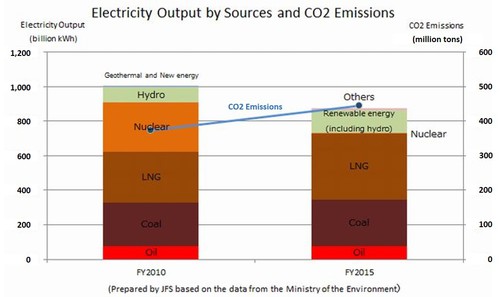June 28, 2017
Japan's Greenhouse Gas Emissions in FY2015 Fall to FY2010 Levels, Conservation and Renewables Cited as Contributors
Keywords: Climate Change Energy Conservation Renewable Energy
The Japanese Ministry of the Environment announced on December 6, 2016, preliminary figures of the country's greenhouse gas (GHG) emissions in fiscal 2015. Total emissions were 1.321 billion tons of carbon dioxide (CO2) equivalent (same unit used below). This was the second consecutive year of decline and the third lowest emissions in the past decade, following 1.31 billion tons in fiscal 2010, a year before the Great East Japan Earthquake. Factors contributing to the decrease included progress in energy conservation and deployment of renewable energy.
Japan's GHG emissions in the last decade fell to their lowest point in fiscal 2009, at 1.248 billion tons, due to the global economic slowdown following the 2008 Lehman Brothers collapse. They then turned upward, reaching 1.45 billion tons in fiscal 2013, in response to nuclear plant shutdowns after the earthquake. In fiscal 2014, they decreased again to 1.362 billion tons thanks to conservation-driven reductions in electricity consumption, as well as the replacement of conventional power generation with renewable sources. In fiscal 2015, they dropped further, by 3.0 percent (41 million tons) from the previous year.
Comparing electricity output in fiscal 2015 with that in fiscal 2010 (before the disaster), it dropped 13.2 percent, to 873.9 billion kilowatt-hours (kWh), from 1.0064 trillion kWh in fiscal 2010. Energy sources in fiscal 2015 included: Nuclear (0.8 percent), Coal (30.8 percent), LNG (43.4 percent), Oil (8.9 percent), Renewable energy (14.9 percent), Other (1.2 percent) (Renewable energy includes hydro). In fiscal 2010: Nuclear (28.6 percent), Coal (25.0 percent), LNG (29.3 percent), Oil (7.5 percent), Hydro (8.5 percent), Geothermal and New energy (1.1 percent).
Carbon dioxide emissions from the energy sector were 444 million tons in fiscal 2015 compared with 374 million tons in fiscal 2010. Photovoltaic generation accounted for a large part of renewable energy, its cumulative installed capacity reaching 35 million kilowatts.
Viewing GHG emissions by type, CO2 accounted for 92.6 percent while other greenhouse gases--four major gases including methane (CH4), nitrous oxide (N2O) and chlorofluorocarbon substitutes (CFCs)--accounted for 7.4 percent in fiscal 2015, compared to 93.2 percent and 6.8 percent, respectively, in fiscal 2010. The increase in emissions from other greenhouse gases was due to a rise in hydrofluorocarbon (HFCs) emissions from refrigerants, which are used as an alternative to ozone-depleting substances.
Energy-derived CO2 emissions were 413 million tons in the industrial sector (including factories), down 1.9 percent compared with fiscal 2010; 216 million tons in the transport sector (including road transport), down 6.9 percent; 249 million tons in the commercial sector (commerce, service, and office), up 14.7 percent; 182 million tons in the household sector, up 5.2 percent; and 88.2 million tons in the energy conversion sector (including power plants), up 10.1 percent. This amounted to a net decrease of 2.3 percent. Compared to fiscal 2014, emissions decreased in every sector.
Rising summer temperatures and declining winter temperatures, which increase demand for air conditioning and heating, tend to drive up CO2 emissions. However, among the months in which more than a 1.0-degree-Celsius difference in monthly average temperature from the previous year was observed in Japan's nine major cities, June was cooler by 1.1 degrees and December warmer by 3.2 degrees. Therefore, temperatures did not appear to contribute to increased CO2 emissions.
Related
"JFS Newsletter"
- Shaping Japan's Energy toward 2050 Participating in the Round Table for Studying Energy Situations
- Implementation of the Paris Climate Agreement: A Report on Japan's Round Table for Studying Energy Situations
- Auto Sales Industry Cooperates to Tackle Social Responsibility: Examples from Yamagata, Japan
- Yokohama FC: Leader in Eco-Activities through Football-Related Carbon Offset
Related
"Popular Articles"
- Large Ozone Hole Observed Again in 2011
- Japan's Pro Baseball Teams Start Eco-Project to Cut Energy Use by 6%
- Manufacturer Saving Energy by Growing Vertical Gardens on Factory Walls
- Sony Draws Up 'Road to Zero' Plan for Zero Environmental Footprint
- Tokyo Announces Innovative 10-Year Strategy against Climate Change



